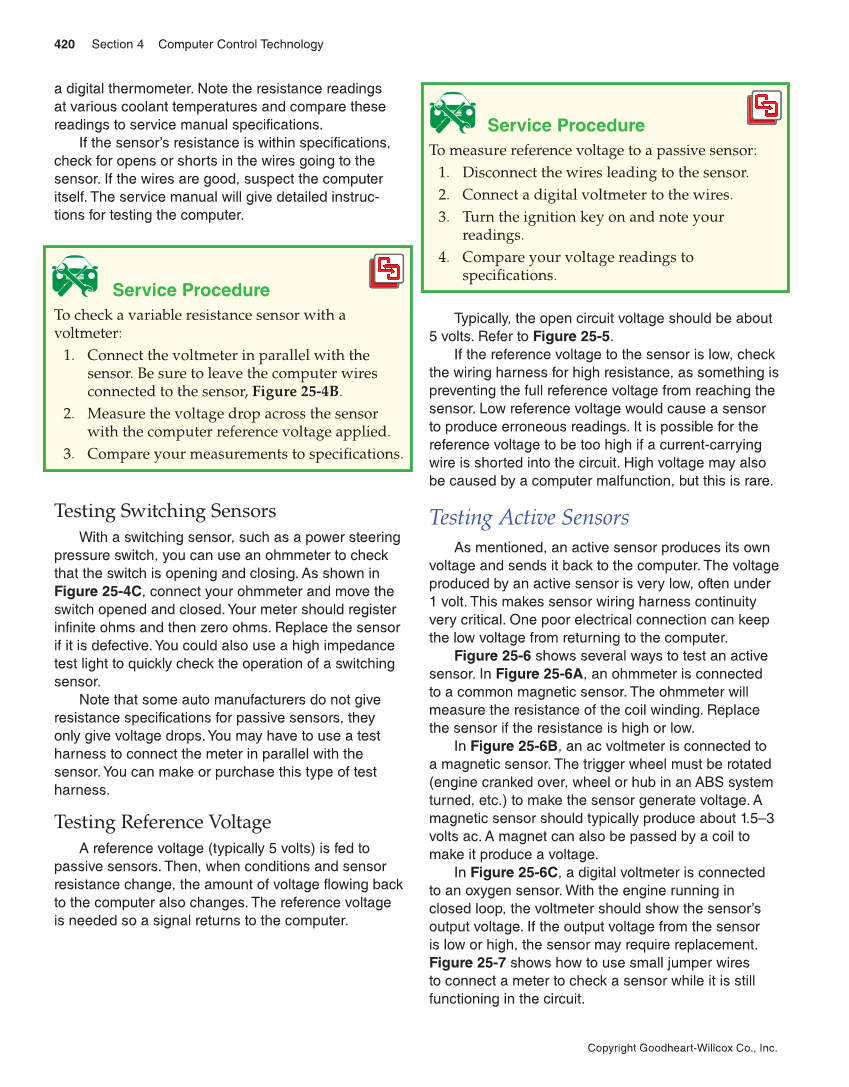420 Section 4 Computer Control Technology Copyright Goodheart-Willcox Co., Inc. a digital thermometer. Note the resistance readings at various coolant temperatures and compare these readings to service manual specifications. If the sensor’s resistance is within specifications, check for opens or shorts in the wires going to the sensor. If the wires are good, suspect the computer itself. The service manual will give detailed instruc- tions for testing the computer. Service Procedure To check a variable resistance sensor with a voltmeter: 1. Connect the voltmeter in parallel with the sensor. Be sure to leave the computer wires connected to the sensor, Figure 25-4B. 2. Measure the voltage drop across the sensor with the computer reference voltage applied. 3. Compare your measurements to specifications. Testing Switching Sensors With a switching sensor, such as a power steering pressure switch, you can use an ohmmeter to check that the switch is opening and closing. As shown in Figure 25-4C, connect your ohmmeter and move the switch opened and closed. Your meter should register infinite ohms and then zero ohms. Replace the sensor if it is defective. You could also use a high impedance test light to quickly check the operation of a switching sensor. Note that some auto manufacturers do not give resistance specifications for passive sensors, they only give voltage drops. You may have to use a test harness to connect the meter in parallel with the sensor. You can make or purchase this type of test harness. Testing Reference Voltage A reference voltage (typically 5 volts) is fed to passive sensors. Then, when conditions and sensor resistance change, the amount of voltage flowing back to the computer also changes. The reference voltage is needed so a signal returns to the computer. Service Procedure To measure reference voltage to a passive sensor: 1. Disconnect the wires leading to the sensor. 2. Connect a digital voltmeter to the wires. 3. Turn the ignition key on and note your readings. 4. Compare your voltage readings to specifications. Typically, the open circuit voltage should be about 5 volts. Refer to Figure 25-5. If the reference voltage to the sensor is low, check the wiring harness for high resistance, as something is preventing the full reference voltage from reaching the sensor. Low reference voltage would cause a sensor to produce erroneous readings. It is possible for the reference voltage to be too high if a current-carrying wire is shorted into the circuit. High voltage may also be caused by a computer malfunction, but this is rare. Testing Active Sensors As mentioned, an active sensor produces its own voltage and sends it back to the computer. The voltage produced by an active sensor is very low, often under 1 volt. This makes sensor wiring harness continuity very critical. One poor electrical connection can keep the low voltage from returning to the computer. Figure 25-6 shows several ways to test an active sensor. In Figure 25-6A, an ohmmeter is connected to a common magnetic sensor. The ohmmeter will measure the resistance of the coil winding. Replace the sensor if the resistance is high or low. In Figure 25-6B, an ac voltmeter is connected to a magnetic sensor. The trigger wheel must be rotated (engine cranked over, wheel or hub in an ABS system turned, etc.) to make the sensor generate voltage. A magnetic sensor should typically produce about 1.5–3 volts ac. A magnet can also be passed by a coil to make it produce a voltage. In Figure 25-6C, a digital voltmeter is connected to an oxygen sensor. With the engine running in closed loop, the voltmeter should show the sensor’s output voltage. If the output voltage from the sensor is low or high, the sensor may require replacement. Figure 25-7 shows how to use small jumper wires to connect a meter to check a sensor while it is still functioning in the circuit.
